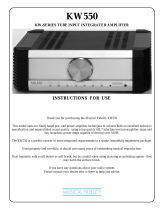
SAFETY INSTRUCTIONS
In order to comply with current European safety regulations
it is essential that the Naim loudspeaker connectors
supplied with amplifiers and loudspeakers are used.
Do not under any circumstances allow anyone to modify
your Naim equipment without first checking with the factory,
your retailer, or your distributor. Unauthorised modifications
will invalidate your guarantee.
Equipment must not be exposed to dripping or splashing
and no objects filled with liquid, such as vases, should be
placed on the equipment.
For your own safety do not under any circumstances open
Naim equipment without first disconnecting it from the
mains.
Warning: an apparatus with CLASS I construction shall
be connected to a mains socket outlet with a protective
earthing connection.
Where the mains plug or an appliance coupler is used as
the disconnect device, the disconnect device shall remain
readily operable. To disconnect the equipment from the
mains remove the mains plug from the mains outlet.
The following label is attached to all mains powered
equipment:
NOTE
This equipment has been tested and found to comply
with the relevant EMC and Safety Standards, and, where
applicable, also complies with the limits for a class B digital
device, pursuant to Part 15 of the FCC Rules.
These limits are designed to provide reasonable protection
against harmful interference in a residential installation.
This equipment generates, uses and can radiate radio
frequency and, if not installed and used in accordance
with the instructions, may cause harmful interference to
radio communications. However, there is no guarantee
that interference will not occur in a particular installation. If
this equipment does cause harmful interference to radio or
television reception, which can be determined by turning
off and on, the user is encouraged to try to correct the
interference by one or more of the following measures:
• Reorient or relocate the receiving antenna.
• Increase the separation between the equipment and the
receiver.
• Connect the equipment into an outlet on a circuit different
from that to which the receiver is connected.
• Consult your Naim retailer or an experienced radio/TV
technician for help.
WARNING
THIS APPARATUS
MUST BE EARTHED
Page Section
E1 1 Connections
E1 2 Mains Power
E2 3 General Installation
E3 4 NAC 552 Introduction and Installation
E4 5 NAC 552 Controls and Connections
E5 6 NAC 552 Specification
E6 7 NAC 252 Introduction and Installation
E6 8 NAC 252 Controls and Connections
E7 9 NAC 252 Specification
E8 10 NAC 282 Introduction and Installation
E8 11 NAC 282 Controls and Connections
E10 12 NAC 282 Specification
E11 13 NAC 202 Introduction and Installation
E11 14 NAC 202 Controls and Connections
E12 15 NAC 202 Specification
E13 16 NAC 152 XS Introduction and Installation
E14 17 NAC 152 XS Controls and Connections
E16 18 NAC 152 XS Specification
E17 19 Supernait Introduction and Installation
E19 20 Supernait Controls and Connections
E21 21 Supernait Specification
E22 22 Nait XS Introduction and Installation
E23 23 Nait XS Controls and Connections
E25 24 Nait XS Specification
E26 25 Nait 5i Introduction and Installation
E26 26 Nait 5i Controls and Connections
E27 27 Nait 5i Specification
E28 28 Preamplifier and Integrated Amplifier
Operation
E31 29 R-com Remote Handset
E32 30 NARCOM 4 Remote Handset
E33 31 NAP 500 Installation and Operation
E34 32 NAP 500 Connections
E34 33 NAP 500 Specification
E35 34 NAP 300 Installation and Operation
E36 35 NAP 300 Connections
E36 36 NAP 300 Specification
E37 37 NAP 250 Installation and Operation
E37 38 NAP 250 Connections
E37 39 NAP 250 Specification
E38 40 NAPV 145 Installation and Operation
E38 41 NAPV 145 Connections
E38 42 NAPV 145 Specification
E39 43 NAP 200 Installation and Operation
E39 44 NAP 200 Connections
E39 45 NAP 200 Specification
E40 46 NAP 155 XS Installation and Operation
E40 47 NAP 155 XS Connections
E40 48 NAP 155 XS Specification
E41 49 NAPV 175 Installation and Operation
E41 50 NAPV 175 Connections
E42 51 NAPV 175 Specification
E42 52 Declarations of Conformity
Contents






















